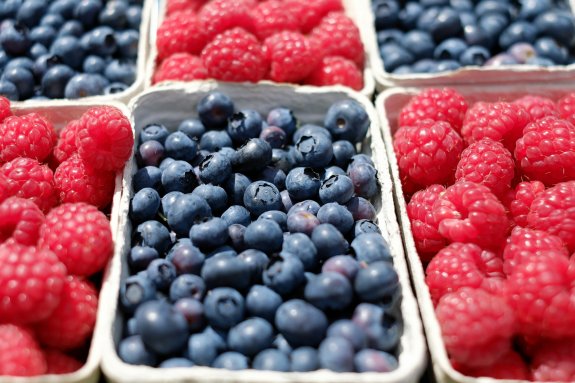Time to Live the Berry Way of Life
The saying “big things come in small packages” has never rung more true when it comes to considering the nutritional value and health benefits associated with including berries in one’s diet.
Chock-full of antioxidants called anthocyanins, berries are among the best sources of other bioactive compounds like flavonols, ellagic acid and resveratrol. These compounds exist in small amounts in food but have a profound effect on physiological and cellular processes in organisms that consume them.
Berries help keep free radicals in check and fight inflammation. They are also high in fiber, and are known to reduce neurodegenerative oxidative stress. There is also evidence that berries help alleviate and prevent cancer, diabetes and macular degeneration. The regular consumption of berries has also been linked to improved cardiovascular function indicated by an increase in HDL cholesterol (”good” cholesterol) and lower blood pressure.
If you haven’t been consuming berries regularly, get to know the more readily available berries below, and add them to your next grocery list or keep them in mind when you get in touch with your trusted food products supplier.
1. Blueberries
The numerous benefits these little blue dynamos bring include their high antioxidant content and polyphenols that help strengthen bones, and preventing menopause-related bone loss in women.
Blueberries are usually grown in places like Chile, the U.S. and Canada. But thanks to international food distributors, you can enjoy them anytime and in various forms, such as when indulging in your favorite gourmet desserts and cheesecakes.
2. Raspberries
High in vitamin C and manganese, raspberries also contain vitamin K, vitamin E, magnesium, pantothenic acid, folate, biotin and omega-3 fatty acids. These fragile but potent red berries are rich in quercetin and gallic acid which are antioxidants known to fight cancer, and prevent heart and circulatory disease as well as age-related neural decline.
Countries supplying raspberries to the rest of the world include Russia, Poland, the U.S. and Serbia.
3. Gooseberries
These berries may be red, green or purple and are used in various food products. Low in calories and also fat- and cholesterol-free, gooseberries have a high fiber content. They are rich in vitamins C and A, pantothenic acid (vitamin B), pyridoxine (vitamin B-6), and thiamine (vitamin B1).
Gooseberries are excellent sources of minerals such as calcium, magnesium, potassium, copper, phosphorus and manganese as well. They help prevent osteoporosis, maintain normal blood pressure, and keep the adrenal glands in tip-top shape.
Gooseberries naturally grow in Europe, and parts of Africa and Asia.
4. Strawberries
Considered the most popular berry type, strawberries have a higher vitamin C content than oranges and are high in folic acid and fiber. Rich in polyphenols and antioxidants, strawberries are known to be good for eyesight and proper brain functioning, and to help alleviate hypertension, gout and arthritis, as well as prevent premature aging. You can best enjoy the health benefits of eating strawberries by purchasing organically produced types.
More commonly grown than other berry types, strawberries come from these top producers: the USA, Turkey, Spain, Egypt, Mexico, Russia and Japan.
5. Grapes
These mini fruits are loaded with vitamins A, C and B6, and also contain potassium, calcium, magnesium and folic acid. Grapes are high in phytonutrients such as phenols and polyphenols. They keep the body hydrated because of their high water content. They also help prevent constipation, indigestion, premature aging, macular degeneration, cataracts, fatigue and kidney disorders.
Grapes come in a variety of colors such as red, white, green, purple and black. They are used for making juice and wine, so you can drink up some of the health benefits grapes offer. Top global grape producers include China, the U.S., Italy, France, Spain and Turkey.
Less widely known berries available mainly in health food stores like acai, camucamu, maqui, noni, acerola, aronia, bilberries and goji are considered exotic because they are not yet commercially grown. Still, they are worth trying when they are available because they are also packed with powerful antioxidants and a number of important nutrients.
Other traditional berries you might want to get to know include mulberries, blackberries, blackcurrants and redcurrants, cranberries, boysenberries – the list is long, varied and interesting. And not to be forgotten, of course, is the humble tomato which is botanically classified as a berry, too.
image source: https://www.pexels.com/u/pixab
AUTHOR BIO
HishamAljamil
Managing Director, Bidfood Middle East
Hisham’s corporate career started in the UAE in late 1988; he worked for firms such as R.J. Reynolds, Danone Group, and Richemont Group across several countries in the GCC. He climbed up the ladder in roles and responsibilities to manage regions and businesses in the Middle East. In 2003, after 15 years of business experience, he took a leap of faith towards starting up something on his own. At almost 10 years in, the business has grown to cover 3 major markets with a turnover exceeding US$60 million. Hisham’s vision is to continue his regional expansion to the rest of the Middle East markets.















